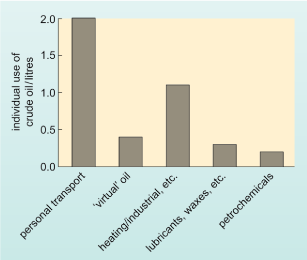4 Oil as a source of modern materials
So far, 3.5 litres of the UK citizen's 4 litre daily allocation of crude oil have been accounted for. The bulk of the remaining 0.5 litres is used as lubricants, waxes and road coverings, but a small proportion of the allocation - in the region of 0.1−0.2 litres - is converted to petrochemicals (Figure 4). As the name implies, these are chemicals derived from crude oil (petroleum), although the term is also used to refer to products derived from natural gas. Petrochemicals are used to manufacture a huge variety of materials - including plastics, pesticides, drugs, adhesives, paints, and so on.
The proportion of crude oil used to make petrochemicals is small but it is a very important part of the story. The economic importance of petrochemicals can be seen from the fact that recently the world production of transport fuels from crude oil was estimated to have a value of US $385 billion, whilst world production of petrochemicals was estimated to have a value of US $375 billion. Over 80% of crude oil is used to make transport fuel, while 3-5% is used for petrochemicals, yet their value is roughly the same.
Examining the statistics is one way to gain an insight into the importance of petrochemicals, but another way is to look at the things around you in your home. Let's return momentarily to my jacket: the lining is made of the synthetic materials polyester and viscose (Figure 3b) - products that are both to a greater or lesser extent derived from crude oil. More precisely, these materials are made from petrochemicals.
Polyester is ultimately derived from a petrochemical called xylene. Viscose is derived from cellulose extracted from plants, in a manufacturing process that incorporates a number of petrochemicals. The plastic buttons, and the dye too, are almost certainly derived from petrochemicals.
It's hard to exaggerate how commonplace petrochemical products have become in our daily lives - we are surrounded by them (Figure 5). We walk on petrochemical products in the form of synthetic fibre carpets and vinyl floorings. The colours on the walls which surround us are derived from petrochemicals. We sit on seats stuffed with plastic foams derived from petrochemicals. Crude oil is the source of almost all the many plastics we use. For example, we get clean water from plastic pipes, whilst other plastic pipes take our waste water away. Our music players, computers and mobile phones are all made in part from plastics derived from oil. The food we eat doesn't just rely on oil for the transport elements of its production; it also relies on the pesticides, herbicides and fertilisers which are usually chemically derived from oil. The packaging which keeps our food fresh or allows us to transfer it directly from the fridge to the oven is derived from oil. Modern medicines are almost always derived from oil, as are replacement heart valves and artificial limbs.
The list of modern goods that rely on the products of the petrochemical industry is almost endless - that is why the small fraction of a barrel of oil used for petrochemicals is so valuable.


